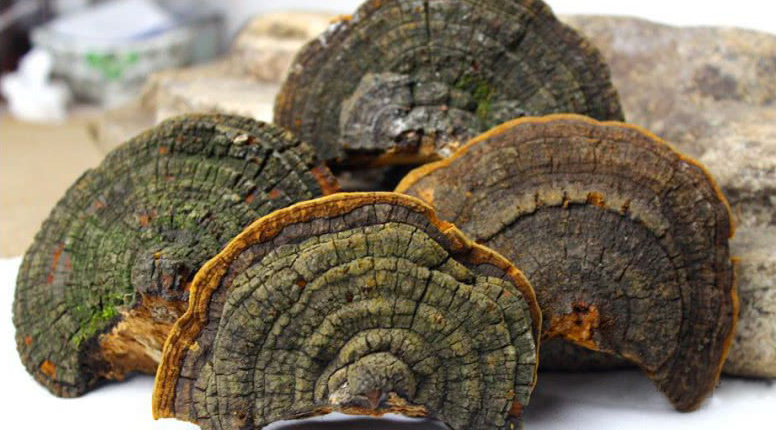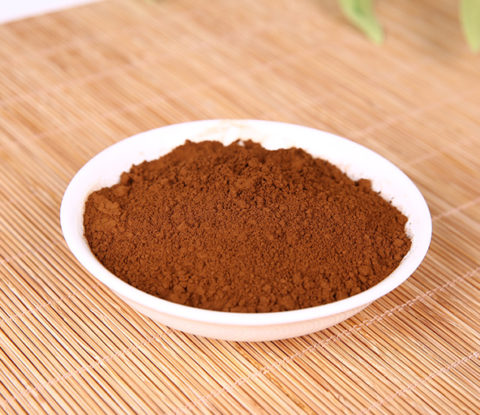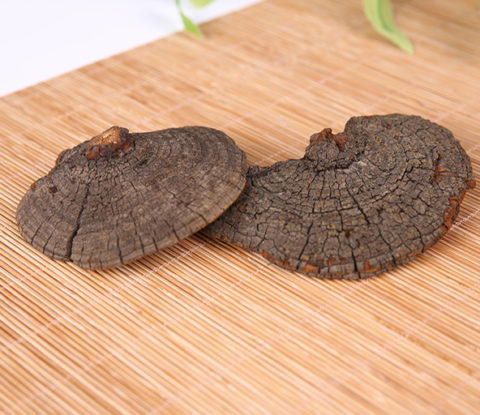
Phellinus Linteus or Phellinus Igniarius Extract Powder Polysacchrides 10-50% UV
Phellinus linteus extract polysacchrides provides the broadest spectrum of anti-cancer properties of any of the mushroom species tested.
Phellinus Linteus/Phellinus Igniarius Extract Powder
[Latin name]: Phellinus linteus(Berk1. et Curt.)Teng/ Phellinus igniarius(L.ex Fr.)Quel
[Part used]: Fruitingbody&mycelium
[Active ingredient]: Polysaccharides
[Specification]: 10%,20%,30%,50%
[Test method]: UV
[Appearance]: Brownish yellow powder
[Particle size]: 95% pass 80 mesh
 Phellinus extract raw materials are Phellinus linteus or Phellinus igniarius, a type of fungus of the family of Hymenochaetaceae. Like other members of the genus of Phellinus it lives by saprotrophic nutrition, in which the lignin and cellulose of a host tree is degraded and is a cause of white rot. Common names are Willow bracket and Fire spong. The fungus forms perennial fruiting bodies that rise as woody-hard, hoof or disc-shaped brackets from the bark of the infested living tree or dead log. The tree species is often willow but it may be commonly found on birch and alder and other broad leafed trees. The top is covered with a dark, often cracked crust, a stem is present only in its infancy. Unlike most fungi it has a hard woody consistency and may persist for many years, building a new surface layer each year. It was prized as kindling material.
Phellinus extract raw materials are Phellinus linteus or Phellinus igniarius, a type of fungus of the family of Hymenochaetaceae. Like other members of the genus of Phellinus it lives by saprotrophic nutrition, in which the lignin and cellulose of a host tree is degraded and is a cause of white rot. Common names are Willow bracket and Fire spong. The fungus forms perennial fruiting bodies that rise as woody-hard, hoof or disc-shaped brackets from the bark of the infested living tree or dead log. The tree species is often willow but it may be commonly found on birch and alder and other broad leafed trees. The top is covered with a dark, often cracked crust, a stem is present only in its infancy. Unlike most fungi it has a hard woody consistency and may persist for many years, building a new surface layer each year. It was prized as kindling material.
Phellinus linteus or Phellinus igniarius is called sanghuang in Chinese. This mushroom has been widely used in ancient herbal medicines in Korea, China, and Japan. In 1968, the antit-umor activity of polysaccharides from Phellinus linteus was first reported. Phellinus linteus is reported to have the most potent antit-umor effect of the basidiomycetes. In the last few decades, the use of Phellinus linteus for suppressing c-ancer or enhancing immunity has been actively investigated. Biological effects were found to be associated with isolated polysaccharides, proteoglycans and other organic compounds. Isolated compounds and comPhellinus linteusex extracts from Phellinus linteus inhibit signal pathways in various c-ancer cells. However, few clinical studies to date have tested the oncologic effects of Phellinus linteus, and only a few cases have demonstrated the therapeutic effect of Phellinus linteus on primary liver c-ancer. In Japan, a patient with hepatocellular carcinoma and multiPhellinus linteuse lung metastases was reported to experience comPhellinus linteusete t-umor regression 6 months after treatment with Phellinus linteus extract. Radiation therapy in combination with Phellinus linteus ingestion resulted in spontaneous remission of hepatocellular carcinoma with skull metastasis in a Korean patient.
Indications Phellinus in Traditional Chinese Medicine
Phellinus linteus has been widely used in Japan, Korea and China. In 1993, Korea has succeeded in developing an anti-tumor medicine from Phellinus linteus. In 1968, Dr. Ikegawa’s research team released their paper “Anti-tumor action of some basidiomycetes, especially Phellinus linteus” in a Japanese medicinal journal; Phellinus linteus became very popular among the researchers and scientists. The efficacy of natural vs cultivated Phellinus mushrooms: “Artificially cultivated Phellinus linteus may be short on efficacy. Only natural ones are genuine Phellinus linteus.” Phellinus linteus grows naturally in trunks of willow, paper mulberry and elm tree that is more than 100 years old, and shall grow for minimum 30 to 40 years to make a fruit body being used for medical application. In addition, the growth conditions such as humidity, temperature and lighting are very delicate, so that Phellinus linteus is very rare in the nature. That is the reason why, it is almost impossible to collect and take a fruit body in the nature.
Phellinus linteus is included in Phellinus genus of Hymenochaetaceae family of Aphylloporales order in mushroom class (Basidiomycetes) that mostly consists of fungi of medical use and edible fungi among molds. It is called Meshima in Japan (Danjo Island), Sanghwang in Korea. Phellinus linteus is written as Sang-I in “Shin-Nong-Bon-Cho-Kyung” of China, Sang Hwang and Sang-Shin in Yak-Sung-Ron of Gyeon Ip-an in Tang era of China, Ho-son-an in Yu-Yang-Jap-Jo of Dan Seoung-sik, Sang-Hwang-Go in Chan-Yo-Gi-Bang, Sang-I and Sang Hwang in Bon-Cho-Gang-Mok of Lee Si-Jin in Ming Dynasty of China and Sang-I and Sang-Hwang in Dong-I-Bo-Gam of Her Jun. In addition, Big Dictionary of Chinese Medicine (Joong-Yak-Dae-Sajeon; Sanghai Science Publishing Company) has the terms such as Sang-Shin, Sang-I, Sang-Hwang-Go and Ho-Son-An.
In the tradition Chinese medicine, Sang Hwang (Phellinus linteus) was classified as Lingzhi or Reishi. Sang Hwang (Phellinus linteus) is the most highly rated herb category in terms of multiple benefit and absence of side effects. As a result from knowledge accumulated through 4000 years of human observation, it asserts that health can be maintained by sustaining the right balance with the body and the disease can be cured by restoring this balance through nutrition, including medicinal herbs, exercise and mental peace. In the other words, a disease is believed to be the tip of an iceberg, the result of the underlying imbalance of the body, which must be restored.
The 2000 years old medical book: Serg Nongs Herbal classic; considered today as the oldest book on oriental herbal medicine, classifies 365 species of roots of grass, woods, furs, animals and stones separates herbal medicines into 3 catagories. The first category, called superior, includes herbs effective for multiple diseases and mostly responsible for maintaining and restoring the body balance. They have no unfavorable side effects. The second category, middle, comprises tonics and boosters and their consumption must not be prolonged. The third category, low, must be taken usually in small dosages and for specific ailments. This category includes some poisonous herbs. Sang Hwang (Phellinus linteus) ranked number one of the superior medicines, is the most exalted medicine in ancient times and has been used for perpetual youth and longevity. All observations show that Sang Hwang (Phellinus linteus) has no side effects and can be consumed in high dosages and in parallel with other medications.
Sang Hwang (Phellinus linteus) has been revered as herbal medicines for thousands of years in China and Japan. Emperors of the great Chinese Dynasties and Japanese royalty drank tea and concoction of the Sang Hwang (Phellinus linteus) for vitality and long life. In Chinese History, the great Emperor Qin (Qin Chi Huang, 220 B.C.) once sent 3000 boys and girls to Japan’s islands to search for a kind of lingzhi for the elixir of eternal youth. Sang Hwang (Phellinus linteus) was believed to be the one.
In the 16th century pharmacopoeia: Pen Tsao Kang Mu, which contains hundreds of medicines the Chinese have used for thousand years, compiler Le Shih – Chen described the uses of Sang Hwang. It positively affected the life energy or qi of the heart, repairing the chest area and benefiting those with a knotted and right chest. He wrote that it also increased intellectual capacity and banished forgetfulness. Taken over a long period of time, ability of the body would not cease and the years would be lengthened to those of the immortal fairies.
In China, the medical literature such as Shin-nou-nonzokyo (Imperial Medicine Handbook), Honzo-komoku (Medicine handbook), Chuusaku-daijitenn (Great dictionary of Chinese Medicines), Chuugoku-yakuyo-shinnkinn (Chinese medical Fungi), and Toyoiguku-daijitenn (Great Dictionary, 1967) describe the efficacy of palsy, gonorrhea, and abdominal pain, and effective for helping urination disorder, stomach problems, hematuria, gripes, penis ache, prolapsus ani, melena, over-work, mense disorder, vitiated blood, lymphatic tumo-r, metrorrhagia, nosebleeds, facial and diarrhea. And in traditional Oriental applications, Sang Hwang is also used to treat insomnia, gastric ulcers, neurasthenia, arthritis, nephritis, asthma, bronchitis, hypertension and poisoning. It is also being used in treating neuromuscular disorders, stress, induce tension, myasthenia gravis and muscular dystrophy – all with varying degrees of success. Presently, Sang Hwang has various applications including lowering or raising blood pressure, stimulating liver actions, blood cleansing, and enhancement of the immune system and the lessening of nervous tension, and acting as an adaptogen in helping the body fight the effects of stress. It is also being recognized for its adjunct use as an immune system stimulator when c-ancer therapy is being used. The use of Sang Hwang as a c-ancer treatment in the Orient is centuries old. In following the concept of qi tonics, Sang Hwang is used to strengthen the body’s resistance to outside forces. When people continue to take the formulation medicine after boiling it for a long time, it works as a “miracle medicine”, refreshing the human body, relieving ailments, and promoting longevity.
Pharmacological Researches on Phellinus Extract
1. Anticancer effects of Phellinus linteus
The biologically active compoundsin PL are reported to be polysaccharides, acidic proteoglycans with mixed α- and β-linkages, and a (1→6)-branched type (1→3)-glycan. In 1969, Chihara et al. demonstrated that polysaccharide extracts from the basidiomycete fungus PL suppressed tumor growth in vivo. Recently, new furopyranone compounds, phellifuropyranone A and meshimakobnol A/B, isolated from fruiting bodies of wild PL, demonstrated antiproliferative activity against mouse melanoma and human lung c-ancer cells in vitro. However, the molecular mechanisms responsible for the direct antit-umor activity have not been fully investigated. Protein-bound polysaccharides isolated from PL suppressed the proliferation and colony formation of colon cancer cells (SW480). This effect was found to be mediated by cell cycle arrest at G2/M phase and associated with down regulation of cyclin B1. Isolated low molecular weight compounds from Phellinus linteus such as hispolon demonstrated a dose-dependent inhibition of human epidermoid KB cell proliferation. Several recent studies demonstrated potential mechanisms of the direct anticancer effects of PL extracts on tumor proliferation, growth and invasiveness).
2. Immunomodulation
Polysaccharides and proteoglycans extracted from Phellinus linteus might stimulate the proliferation of T lymphocytes and the humoral immune function, resulting in a secretory and cellular macrophage response. Nonspecific immune functions mediated by natural killer cells and macrophages increased in vivo and in vitro with treatment with Phellinus linteus. Phellinus linteus stimulated humoral immune functions such as T-dependent and -independent primary antibody responses, and acted as a polyclonal activator of B cells. Phellinus linteus exhibited a wider range of immunostimulation and antit-umor activity than other polysaccharides isolated from other basidiomycetes. Kim et al. demonstrated that a novel polysaccharide-protein complex extracted from Phellinus linteus markedly increased B-cell proliferation, production of cytokines and nitric oxide from macrophages, and NK cell-mediated killing of YAC-1 lymphoma cells in vitro. These results suggest that Phellinus linteus is a biological response modifier. In vivo, when HT- 29 colon cancer cell-bearing mice were treated with proteoglycans extracted from Phellinus linteus, a relative increase in spleen and thymus weights were noted.
Significant changes in plasma biochemical parameters showed that Phellinus linteus acted as an immunopotentiator partly through protecting T cells and enhancing mucosal IgA responses. In human hepatoma (Hep3B) cell-transplanted mice, an extract of a mycelial culture from Phellinus linteus induced significant reduction of tumor size and increased T cell numbers, and increased IL-2, IFN-γ, and TNF-α secretion and NK cell activity and phagocytic ability. NK cells are especially known for their ability to lyse a variety of tumor cells by exocytosis of perforincontaining granules, subsequently forming lytic pores by perforin on the target cell membrane. In addition, NK cells are responsible for early inhibitory effects on tumor growth and for long-term t-umorsuppressive effects.The importance of innate immunity in pancreatic cancer was recently reiterated by the strong correlation between the absolute numbers of NK cells circulating in patients before chemotherapy and survival and progression-free interval. The average percentage of NK cells before therapy positively correlated with NK cytotoxic lytic units, suggesting that cytotoxic functions of NK cells are important in pancreatic cancer. This suggests that PL-induced immunomodulation, especially regarding NK cell activity, needs to be further evaluated in treating cancer patients.
3. Inhibition of Metastasis
Chemotherapy is an important therapeutic modality for managing a variety of c-ancers. However, chemotherapy frequently fails to achieve a satisfactory therapeutic outcome such as complete remission or prevention of distant metastasis with no major chemotherapy-related side effects. Cancer metastasis, in particular, is a major medical problem in treating cancer. The potential application of Phellinus linteus as an immunotherapeutic agent, especially for cancer metastasis, has been actively investigated. Phellinus linteus alone significantly prolonged the survival rate of B16F10 cell-implanted mice, inhibited tumor growth in NCI-H cell-implanted nude mice, and reduced the frequency of pulmonary metastasis of B16F10 cell melanomas compared to adriamycin, which significantly inhibited tumor growth, but only slightly inhibited metastasis. Phellinus linteus was not directly toxic to cancer cells, suggesting its mechanism is through stimulation of the immune response. In another study, Phellinus linteus markedly inhibited melanoma cell metastasis in mice by a direct inhibitory effect on the adhesion to and invasion through the extracellular matrix of cancer cells.
In addition, Phellinus linteus increased macrophage NO production. Lee et al. demonstrated that Phellinus linteus might inhibit metastasis at least in part through the regulation of urokinase type plasminogen activator (uPA) associated with t-umor cell-induced platelet aggregation. Although PL showed no cytotoxicity against invasive melanoma cells (B16BL6 cells), Phellinus linteus inhibited platelet aggregation induced by B16BL6 cells. It also disrupted the adhesion to gelatin and invasion of B16BL6 cells in a concentration-dependent manner. PL dose-dependently inhibited pulmonary metastatic colonies up to 55.5% in C57BL/6 mice intravenously injected with B16BL6 cells compared with untreated controls. In addition, PL resulted in concentration-dependent down regulation of the expression of uPA, a key protein in invasion and metastasis of tumor cells. Recurrence, especially of distant liver metastasis, is a major problem in treating pancreatic cancer following margin-negative pancreatectomy. Recently, FOLFIRINOX successfully demonstrated excellent survival in patients with metastatic pancreatic cancer. However, the significant side effects could limit its general application in clinical practice. Therefore, effective anti-metastatic therapeutic agents need to be further investigated. Phellinus linteus may be a potential candidate as a natural nontoxic agent.
4. Antitumor Activity of Mushroom Derivatives on Pancreatic Cancer
Till now, no study has been performed about the anticancer effect of Phellinus linteus, however, there are a few experimental data supporting potential anti-tumor activity of mushroom against pancreatic cancer. Simply, although it was not related to Phellinus linteus, another mushroom extract from Cyathusstriatus was shown to inhibit the viability of human pancreatic adenocarcinoma cells; HPAF-II and Phellinus linteus. It was noted that growth inhibition could be achieved even in low concentration with short exposure period. The growth of pancreatic cancer BXPC3 cells also were found to markedly be inhibited by MMH01, a compound isolated from Antrodiacinnamomea. In BxPC3 cells, MMH01 treatment resulted in ballooning, a unique morphologic changes known as an early apoptosis. This morphologic changes, but no DNA fragmentation suggested the mode of cell death induced by MMH01 in pancreatic cacnerBxPC3 might be apoptosis-associated events of necrosis. Recently, the underlying potential mechanisms were actively investigated. Yu et al. demonstrated that antroquinonol, a ubiquinone derivative isolated from a camphor tree mushroom, Antrodiacamphorata, induced a concentration-dependent inhibition of cell proliferation in pancreatic cancer PANC-1 and AsPC-1 cells. This antic-ancer activity in human pancreatic cancers was found to be through an inhibitory effect on PI3-kinase/Akt/mTOR pathways, which results in down-regulation of cell cycle regulators. It was also noted that antroquinonol induces the cross talk between apoptosis, autophagic cell death and accelerated senescence by up-regulation of p21WAF/Cip1 and K-ras. With regarding cyclin-dependent kinase inhibitor, p21WAF/ Cip1, Rosendahl et al. also found that Polysaccharide K (PSK) increases p21WAF/Cip1 and promotes apoptosis in pancreatic cancer cells. They showed the antiproliferative action of PSK in BxPC-3, PANC-1, MIAPaCa-2, and AsPC-1 was associated with up-regulated cell cycle regulatory p21WAF/Cip1 and pro-apoptotic protein Bax levels, resulting in cell cycle arrest and induction of apoptosis.




